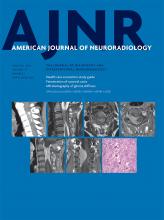Index by author
Rebsamen, S.L.
- FELLOWS' JOURNAL CLUBPediatric NeuroimagingYou have accessDeep Brain Nuclei T1 Shortening after Gadobenate Dimeglumine in Children: Influence of Radiation and ChemotherapyS. Kinner, T.B. Schubert, R.J. Bruce, S.L. Rebsamen, C.A. Diamond, S.B. Reeder and H.A. RowleyAmerican Journal of Neuroradiology January 2018, 39 (1) 24-30; DOI: https://doi.org/10.3174/ajnr.A5453
The authors reviewed clinical charts and images of patients 18 years of age or younger with ≥4 gadobenatedimeglumine–enhanced MRIs for 6 years. Seventy-six children (60 unconfounded by treatment, 16 with radiochemotherapy) met the selection criteria. T1 signal intensity ratios for the dentate to pons and globus pallidus to thalamus were calculated and correlated with number of injections, time interval, and therapy. Among the 60 children without radiochemotherapy, only 2 had elevated T1 signal intensity ratios. Twelve of the 16 children with radiochemotherapy showed elevated signal intensity ratios. Statistical analysis demonstrated a significant signal intensity ratio change for the number of injections. Compared with published adult series, children show a similar pattern of T1 hyperintense signal changes of the dentate and globus pallidus after multiple gadobenatedimeglumine injections. The T1 signal changes in children are accelerated by radiochemotherapy.
Reeder, S.B.
- FELLOWS' JOURNAL CLUBPediatric NeuroimagingYou have accessDeep Brain Nuclei T1 Shortening after Gadobenate Dimeglumine in Children: Influence of Radiation and ChemotherapyS. Kinner, T.B. Schubert, R.J. Bruce, S.L. Rebsamen, C.A. Diamond, S.B. Reeder and H.A. RowleyAmerican Journal of Neuroradiology January 2018, 39 (1) 24-30; DOI: https://doi.org/10.3174/ajnr.A5453
The authors reviewed clinical charts and images of patients 18 years of age or younger with ≥4 gadobenatedimeglumine–enhanced MRIs for 6 years. Seventy-six children (60 unconfounded by treatment, 16 with radiochemotherapy) met the selection criteria. T1 signal intensity ratios for the dentate to pons and globus pallidus to thalamus were calculated and correlated with number of injections, time interval, and therapy. Among the 60 children without radiochemotherapy, only 2 had elevated T1 signal intensity ratios. Twelve of the 16 children with radiochemotherapy showed elevated signal intensity ratios. Statistical analysis demonstrated a significant signal intensity ratio change for the number of injections. Compared with published adult series, children show a similar pattern of T1 hyperintense signal changes of the dentate and globus pallidus after multiple gadobenatedimeglumine injections. The T1 signal changes in children are accelerated by radiochemotherapy.
Rempel, J.L.
- InterventionalOpen AccessTime for a Time Window Extension: Insights from Late Presenters in the ESCAPE TrialJ.W. Evans, B.R. Graham, P. Pordeli, F.S. Al-Ajlan, R. Willinsky, W.J. Montanera, J.L. Rempel, A. Shuaib, P. Brennan, D. Williams, D. Roy, A.Y. Poppe, T.G. Jovin, T. Devlin, B.W. Baxter, T. Krings, F.L. Silver, D.F. Frei, C. Fanale, D. Tampieri, J. Teitelbaum, D. Iancu, J. Shankar, P.A. Barber, A.M. Demchuk, M. Goyal, M.D. Hill and B.K. Menon for the ESCAPE Trial InvestigatorsAmerican Journal of Neuroradiology January 2018, 39 (1) 102-106; DOI: https://doi.org/10.3174/ajnr.A5462
Retico, A.
- Adult BrainOpen AccessSemiautomated Evaluation of the Primary Motor Cortex in Patients with Amyotrophic Lateral Sclerosis at 3TG. Donatelli, A. Retico, E. Caldarazzo Ienco, P. Cecchi, M. Costagli, D. Frosini, L. Biagi, M. Tosetti, G. Siciliano and M. CosottiniAmerican Journal of Neuroradiology January 2018, 39 (1) 63-69; DOI: https://doi.org/10.3174/ajnr.A5423
Rogers, D.M.
- Adult BrainYou have accessAssociation of Developmental Venous Anomalies with Demyelinating Lesions in Patients with Multiple SclerosisD.M. Rogers, M.E. Peckham, L.M. Shah and R.H. WigginsAmerican Journal of Neuroradiology January 2018, 39 (1) 97-101; DOI: https://doi.org/10.3174/ajnr.A5374
Rowley, H.A.
- FELLOWS' JOURNAL CLUBPediatric NeuroimagingYou have accessDeep Brain Nuclei T1 Shortening after Gadobenate Dimeglumine in Children: Influence of Radiation and ChemotherapyS. Kinner, T.B. Schubert, R.J. Bruce, S.L. Rebsamen, C.A. Diamond, S.B. Reeder and H.A. RowleyAmerican Journal of Neuroradiology January 2018, 39 (1) 24-30; DOI: https://doi.org/10.3174/ajnr.A5453
The authors reviewed clinical charts and images of patients 18 years of age or younger with ≥4 gadobenatedimeglumine–enhanced MRIs for 6 years. Seventy-six children (60 unconfounded by treatment, 16 with radiochemotherapy) met the selection criteria. T1 signal intensity ratios for the dentate to pons and globus pallidus to thalamus were calculated and correlated with number of injections, time interval, and therapy. Among the 60 children without radiochemotherapy, only 2 had elevated T1 signal intensity ratios. Twelve of the 16 children with radiochemotherapy showed elevated signal intensity ratios. Statistical analysis demonstrated a significant signal intensity ratio change for the number of injections. Compared with published adult series, children show a similar pattern of T1 hyperintense signal changes of the dentate and globus pallidus after multiple gadobenatedimeglumine injections. The T1 signal changes in children are accelerated by radiochemotherapy.
Roy, D.
- InterventionalOpen AccessTime for a Time Window Extension: Insights from Late Presenters in the ESCAPE TrialJ.W. Evans, B.R. Graham, P. Pordeli, F.S. Al-Ajlan, R. Willinsky, W.J. Montanera, J.L. Rempel, A. Shuaib, P. Brennan, D. Williams, D. Roy, A.Y. Poppe, T.G. Jovin, T. Devlin, B.W. Baxter, T. Krings, F.L. Silver, D.F. Frei, C. Fanale, D. Tampieri, J. Teitelbaum, D. Iancu, J. Shankar, P.A. Barber, A.M. Demchuk, M. Goyal, M.D. Hill and B.K. Menon for the ESCAPE Trial InvestigatorsAmerican Journal of Neuroradiology January 2018, 39 (1) 102-106; DOI: https://doi.org/10.3174/ajnr.A5462
Rusinek, H.
- LETTERYou have accessReply:S.K. Thakur, Y. Serulle, N.P. Miskin, H. Rusinek, J. Golomb and A.E. GeorgeAmerican Journal of Neuroradiology January 2018, 39 (1) E7; DOI: https://doi.org/10.3174/ajnr.A5525
Saba, L.
- Extracranial VascularYou have accessCT Attenuation Analysis of Carotid Intraplaque HemorrhageL. Saba, M. Francone, P.P. Bassareo, L. Lai, R. Sanfilippo, R. Montisci, J.S. Suri, C.N. De Cecco and G. FaaAmerican Journal of Neuroradiology January 2018, 39 (1) 131-137; DOI: https://doi.org/10.3174/ajnr.A5461
Sanelli, P.C.
- You have accessInfluences for Gender Disparity in Academic NeuroradiologyM. Ahmadi, K. Khurshid, P.C. Sanelli, S. Jalal, T. Chahal, A. Norbash, S. Nicolaou, M. Castillo and F. KhosaAmerican Journal of Neuroradiology January 2018, 39 (1) 18-23; DOI: https://doi.org/10.3174/ajnr.A5443








